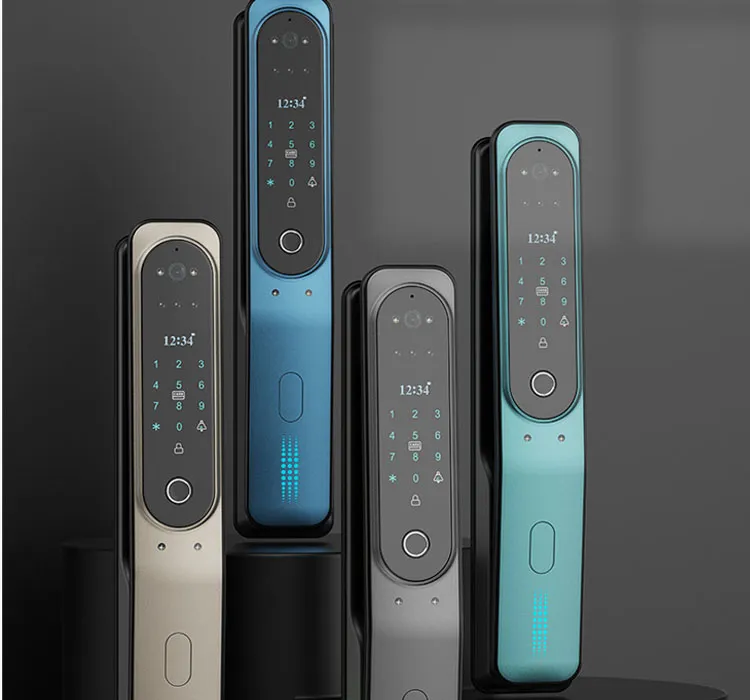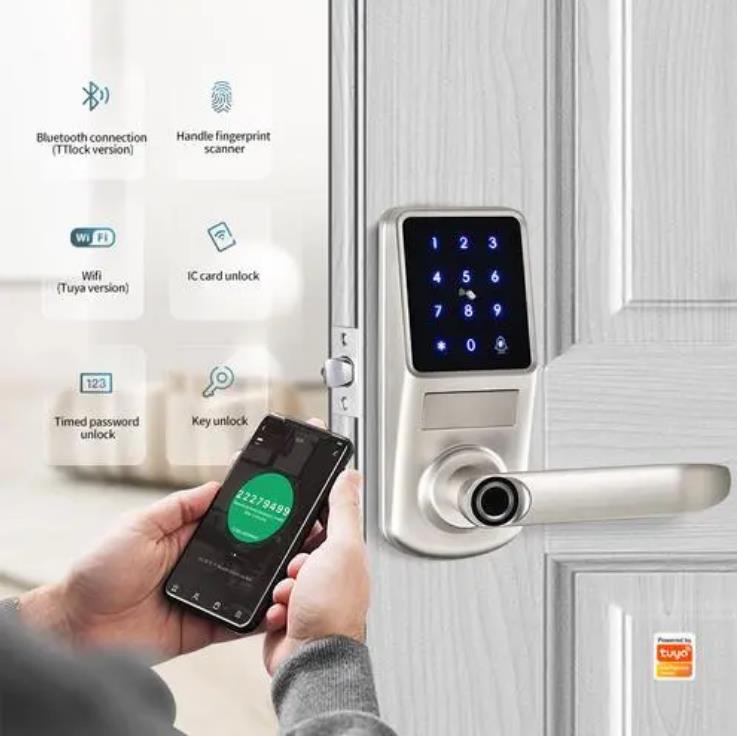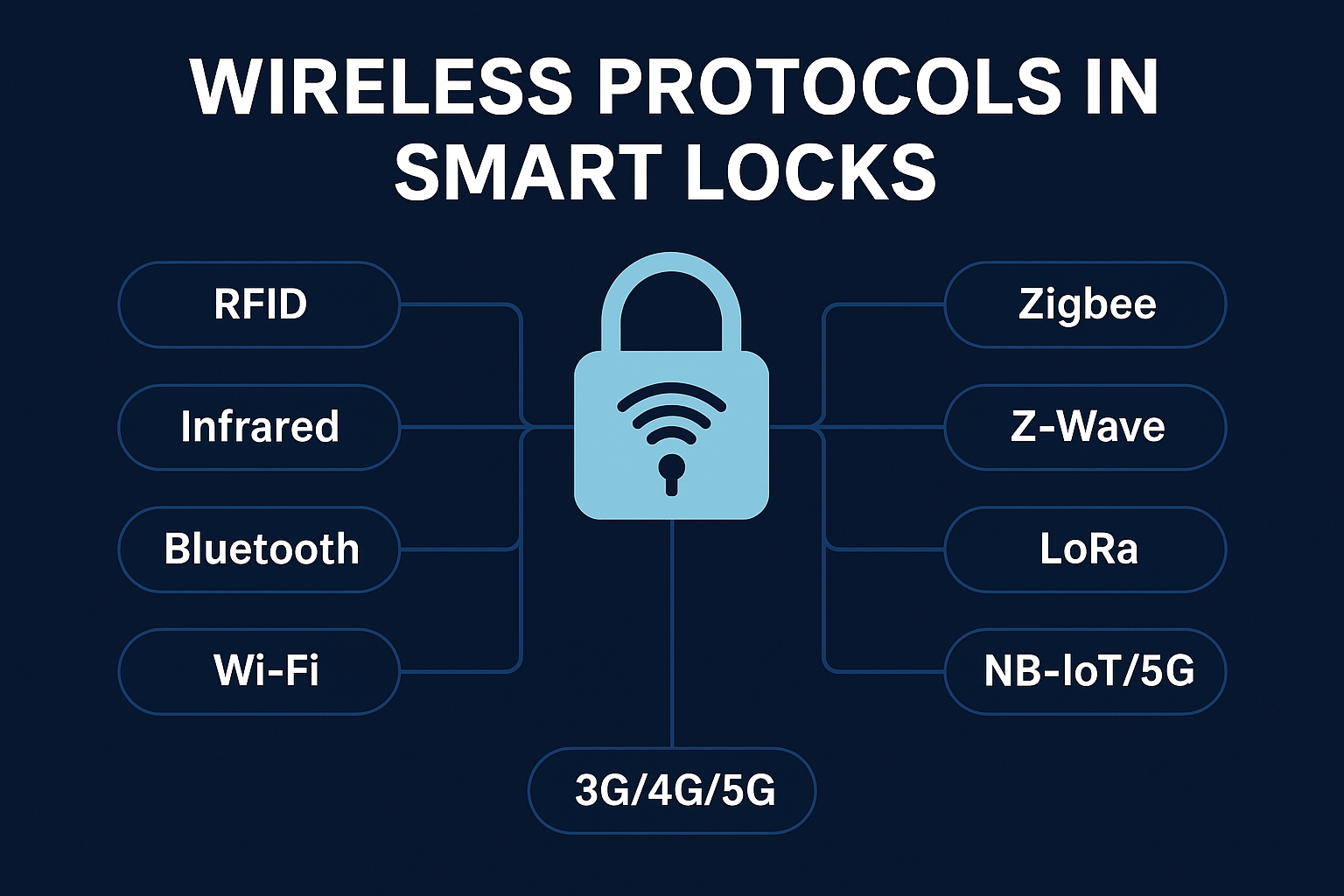Top Wireless Protocols in Smart Locks and Smart Homes | YonAnn A Complete 2025 Guide

With the rapid rise of the Internet of Things (IoT), smart homes and smart locks have become increasingly interconnected. Wireless transmission protocols play a crucial role in enabling secure, reliable communication between devices. This guide explores the most popular wireless communication protocols used in smart lock systems and smart homes in 2025.
-
What Is IoT and Why It Matters in Smart Locks
IoT refers to the integration of information and physical space. It enables automatic identification, data collection, remote monitoring, and device control. In smart locks, IoT facilitates real-time access control, remote management, and seamless integration with other smart devices.
-
Common Wireless Protocols in Smart Lock Technology
RFID
Radio Frequency Identification (RFID) uses electromagnetic fields to automatically identify and track tags attached to objects. It is a non-contact automatic diagnosis technology, through the radio frequency signal automatic recognition target object and obtains the relevant data.
RFID consists of three basic elements: tag (Tag), reader (Reader), and antenna (Antenna). the basic working principle of RFID technology is not complicated, the tag enters the magnetic field, receives the radio frequency signal from the reader, and sends out the product information stored in the chip by the energy obtained from the induction current (Passive Tag, Passive Tag or Passive Tag), or actively sends a certain product information (Passive Tag). The decoder reads the information decodes it, and then sends it to the central information system for relevant data processing.
RFID can be widely used in security and anti-counterfeiting, industrial and commercial automation, property protection, the logistics industry, vehicle tracking, parking lots, and non-stop toll systems for highways, etc. Industry-wise, RFID will penetrate various fields including automotive, pharmaceutical, food, transportation, energy, military, animal management, and personnel management.

Infrared technology is also a type of wireless communication technology that allows for wireless data transmission. Infrared has distinct characteristics: point-to-point transmission, wireless, cannot be too far away, has to be aligned in the right direction, cannot penetrate walls and obstacles, and has little control over the progress of information transmission. 802.11 physical layer standard includes standards related to infrared in addition to the use of RF at 2.4GHz frequency. irDA1.0 supports communication rates of up to 115.2kbps, and IrDA1.1 supports up to 4 Mbps. The technology has largely been phased out and replaced by Bluetooth and newer technologies.
Bluetooth
Bluetooth: Bluetooth communication technology is a wireless communication technology used to connect devices nearby. Bluetooth uses the 2.4 GHz frequency band and is capable of transmitting data over short distances. Bluetooth can be used in smart door locks to connect to cell phones or other devices for remote control and management.
Advantages:
-
Short transmission distance, suitable for proximity communication.
-
Low power consumption, suitable for battery-powered devices.
-
Fast enough to meet the needs of most applications.
-
No additional infrastructure is required, allowing easy connectivity between devices.
Disadvantages:
-
Limited transmission distance, usually within 10 meters.
-
Less secure and susceptible to interference.
-
Bluetooth communication technology is more widely used in smart door locks because of its high reliability and stability. However, due to the limited transmission distance, it may not be sufficient in some application scenarios.
Wi-Fi
Wi-Fi enables remote control via home networks, providing high data bandwidth but with higher power consumption. is a wireless communication protocol used to communicate between smart door locks as well as other devices. Wi-Fi can use radio waves in the 2.4 GHz and 5 GHz bands to transmit data, and uses the IEEE 802.11 standard for communication.
A smart door lock usually needs to be connected to your home’s wireless router so that you can control it remotely from your phone or other device. You can use your smartphone or other device to control the smart door lock via a Wi-Fi connection, such as opening or closing the door. You can also use the app provided with the smart door lock to control the smart door lock and set different access rights.
Benefits:
Advantages:
-
Broadband: Wi-Fi can provide a large bandwidth and can transmit large amounts of data at the same time.
-
Distance: Wi-Fi can cover large distances, making it suitable for indoor use.
-
Configuration: Wi-Fi can be easily configured to support multiple network typologies.
-
Compatibility: Wi-Fi has good compatibility and can be compatible with a wide range of devices.
Disadvantages:
-
Security: Wi-Fi has low security and is vulnerable to hackers.
-
Dependency: Wi-Fi is dependent on the wireless router and if the router fails, the entire system is interrupted.
-
Fluctuating: Wi-Fi signals are subject to interference from the surrounding environment and signal strength can fluctuate.
-
Power consumption: Wi-Fi devices consume more power, which has an impact on battery life.

Zigbee
Zigbee supports mesh networking, low power usage, and secure communications, ideal for home automation. It uses a self-organizing network that allows devices to form a low-power network with each other, and Zigbee can transmit data over long distances (hundreds of meters).
The Zigbee communication protocol is based on the IEEE 802.15.4 standard and has the advantages of low cost, low power consumption, and high security. Zigbee communication protocol has good wall penetration and anti-interference capability, and smart door locks use Zigbee as
Zigbee is used as a wireless communication protocol for smart door locks, which can reduce power consumption while ensuring communication distance. In addition, Zigbee also has good security, which can effectively protect the communication content of the smart door lock from being stolen.
Zigbee as a wireless communication protocol for smart door locks has the following advantages.
-
Low cost: The production cost of Zigbee modules is relatively low, and using Zigbee as a wireless communication protocol can reduce the cost of smart door locks.
-
Low power consumption: Zigbee uses a self-organizing network, which can effectively reduce the power consumption of nodes and is more suitable for applications such as smart door locks that require a long power supply.
-
High security: Zigbee protocol has good security, which can ensure the security of the communication content.
-
Strong wall penetration: Zigbee signals can pass through walls, making the communication distance of smart door locks better guaranteed.
-
Strong anti-interference ability: Zigbee protocol has strong anti-interference ability, which can effectively avoid interference in communication.
However, Zigbee also has some drawbacks.
-
Short communication distance: The communication distance of Zigbee is generally within 30 meters, which cannot meet the needs of some special application scenarios.
-
Low communication rate: The communication rate of Zigbee is generally below 250 Kbps, which cannot meet the demand for high-speed transmission.
-
Slow network establishment: Zigbee network establishment speed is slow and cannot meet the high demand for real-time application scenarios.

Z-Wave
Wave offers reliable signal transmission, strong encryption, and device compatibility for smart homes. Z-Wave is a low-power, low-frequency wireless communication protocol that can be used in home automation systems. Z-Wave can transmit data over long distances (hundreds of meters) and has good signal stability. It uses ultra-low power radio waves to transmit data.
Z-Wave has a low transmission rate and is often used to transmit control and status information. It uses encryption technology to ensure the security of data transmission and can be compatible with a wide range of smart home devices. However, the transmission distance of Z-Wave is short and It is suitable for indoor use, and the cost of the device is relatively high.
Advantages:
-
Security: Z-Wave uses encryption technology to ensure the security of data transmission.
-
Energy efficiency: Z-Wave devices use ultra-low power technology to extend battery life.
-
Compatibility: Z-Wave supports the interconnection of multiple devices and can be compatible with a wide range of smart home devices.
-
Stability: Z-Wave can extend network coverage through repeaters with stable signals.
Disadvantages:
-
Bandwidth: Z-Wave’s bandwidth is low and cannot transmit large amounts of data.
-
Distance: The transmission distance of Z-Wave is short, and suitable for indoor use.
-
Cost: The cost of Z-Wave devices is relatively high.
-
Compatibility: Z-Wave is only compatible with devices that support the Z-Wave protocol, not with all devices.
LoRa
LoRa provides long-range, low-power communication, suitable for wide-area smart lock applications. It is a low-power wireless communication protocol, which is mainly used in IOT applications. Lora adopts FSK modulation with Lora modulation, which can support long-range communication. Lora has the advantages of low power consumption, long-range communication, and low cost, and is used in IOT applications such as smart door locks.
The communication distance of Lora can reach tens of kilometers and can pass through walls, making the communication distance of smart door locks better guaranteed. In addition, LoRa also has better anti-interference capability, which can effectively avoid interference in communication. However, the communication rate of LoRa is relatively low, generally within a few hundred bps.
It cannot meet the demand for high-speed transmission.
LoRa as a wireless communication protocol for smart door locks has the following advantages.
-
Low power consumption: LoRa adopts a low-power modulation method, which effectively reduces the power consumption of the node and makes it more suitable for applications such as smart door locks that require a long power supply.
-
Long distance communication: The communication distance of LoRa can reach tens of kilometers, which makes the communication distance of smart door lock better guaranteed.
-
Low cost: The production cost of Lora modules is relatively low, and using LoRa as a wireless communication protocol can reduce the cost of smart door locks.
-
Strong anti-interference ability: LoRa has a strong anti-interference ability, which can effectively avoid interference in communication.
However, LoRa also has some disadvantages.
-
Low communication rate: The communication rate of LoRa is generally within a few hundred bps, which cannot meet the demand for high-speed transmission.
-
Slow network establishment: The establishment speed of the LoRa network is slow, which cannot meet the application scenarios with high requirements for real-time.
-
Sensitive to path loss: The signal of LoRa is sensitive to path loss, and when the path loss increases, the signal will become weaker and affect the communication quality.

NB-IoT
NB-IoT is a cellular technology offering deep coverage, long battery life, and cost-effective deployment. It is located in the carrier-class, low-rate IoT market based on authorized spectrum and has a broad application prospect. Environmental monitoring, smart parking, remote meter reading, agriculture, and animal husbandry. These scenarios are difficult to support by existing mobile communications. Market research firm Machina predicts that NB-IoT technology will cover 25% of IoT connections in the future.
NB-IoT is an important enhancement technology of LTE in the 3GPP R13 stage, and the RF bandwidth can be as low as 0.18 MHz. NB-IoT is a convergence of two standards, NB-CIoT and NB-LTE, balancing the interests of all parties and applicable to a wider range of deployment scenarios. Among them, Huawei, Vodafone, Qualcomm, and other companies support NB-CIoT; Ericsson, ZTE, Samsung, Intel, MTK, and other companies support NB-LTE. NB-CIoT and NB-LTE have large differences compared with standard NB-IoT, and terminals cannot be smoothly upgraded, and some non-standard base stations even face the risk of withdrawal from the network.
Some advantages of NB-LoT include:
Low power consumption: NB-LoT devices can operate for long periods on small batteries, making them suitable for use in remote or hard-to-reach locations.
Long range: NB-LoT can cover large distances, up to several kilometers, depending on the environment.
Low cost: NB-LoT devices are relatively inexpensive to produce, making them a cost-effective choice for many IoT applications.
Low data rates: NB-LoT is designed for applications that do not require high data rates, making it suitable for simple IoT applications such as sensor networks.
Some potential disadvantages of NB-LoT include:
Limited bandwidth: NB-LoT has a relatively narrow bandwidth, which means it can only transmit a limited amount of data at a time. This may make it unsuitable for applications that require high data rates or large amounts of data to be transmitted.
Limited number of connected devices: The narrowband nature of NB-LoT means that it can only support a limited number of connected devices at a time.
Range may be affected by environmental conditions: The range of NB-LoT can be affected by environmental factors such as buildings, trees, and other obstacles, which can reduce the effective range of the technology.
Overall, NB-LoT is a useful technology for enabling low-power, low-bandwidth IoT applications to communicate over long distances. However, its limited bandwidth and the potential for range to be affected by environmental factors may make it unsuitable for certain types of applications.
3G/4G/5G
These mobile networks offer high-speed connectivity and remote control functionality.
-
Comparison Table of Protocols
|
Protocol
|
Range
|
Speed
|
Power
|
Cost
|
Suitable For
|
|
Wi-Fi
|
High
|
High
|
High
|
Medium
|
Remote access
|
|
Zigbee
|
Medium
|
Low
|
Low
|
Low
|
Mesh home use
|
|
LoRa
|
Very High
|
Very Low
|
Low
|
Low
|
Outdoor smart locks
|
|
Bluetooth
|
Medium
|
Very Low
|
Low
|
Local smart locks
|
-
Choosing the Right Protocol for Your Smart Lock System

Choosing the right wireless protocol depends on your application needs: range, power source, device compatibility, and installation environment. For instance, Zigbee or Z-Wave are great for home networks, while LoRa and NB-IoT are better for industrial or long-distance applications.
-
Future Trends in Wireless Communication for Smart Locks
The future of smart lock communication will focus on interoperability, security, and low power consumption. Protocols like Matter, NB-IoT, and LoRa are expected to dominate with more open standards and support for seamless integration.
Conclusion
Understanding the differences between wireless communication protocols helps in choosing the most suitable one for your smart lock system. At YonAnn, we provide cutting-edge smart lock solutions that integrate seamlessly with leading IoT technologies.
